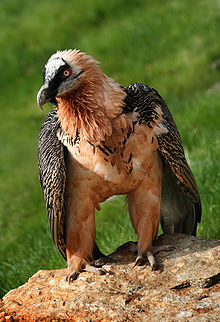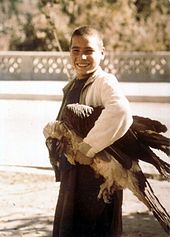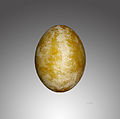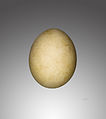- Bearded Vulture
-
Bearded Vulture 
Conservation status Scientific classification Kingdom: Animalia Phylum: Chordata Class: Aves Order: Falconiformes
(or Accipitriformes, q.v.)Family: Accipitridae Subfamily: Aegypiinae Genus: Gypaetus
Storr, 1784Species: G. barbatus Binomial name Gypaetus barbatus
(Linnaeus, 1758)The Lammergeier, Lammergeyer, or Bearded Vulture, Gypaetus barbatus ("Bearded Vulture-Eagle"), is the only member of the genus Gypaetus. Traditionally considered an Old World vulture, it actually forms a minor lineage of Accipitridae together with the Egyptian Vulture (Neophron percnopterus), its closest living relative. They are not much more closely related to the Old World vultures proper than to, for example, hawks, and differ from the former by their feathered neck. Although quite dissimilar, Egyptian and Bearded Vulture both have a lozenge-shaped tail that is unusual among birds of prey.
It eats mainly carrion and lives and breeds on crags in high mountains in southern Europe, North Africa, Southern Africa,[2] the Indian Subcontinent, and Tibet, laying one or two eggs in mid-winter which hatch at the beginning of spring. Populations are resident.
Contents
Description
Unlike most vultures, the Lammergeier does not have a bald head. This huge bird is 94–125 cm (37–49 in) long with a wingspan of 2.31–3 m (7.6–9.8 ft), and is quite unlike most other vultures in flight due to its large, narrow wings and long, wedge-shaped tail, which measures 43–52 cm (17–20 in) in length. It weighs 4.5–7.8 kg (9.9–17 lb), with the nominate race averaging 6.21 kg (13.7 lb) and G. b. meridionalis averaging 5.7 kg (13 lb). Females are slightly larger than males.[3][4]
The adult has a buff-yellow body and head, the latter with the black moustaches which give this species its alternative name. It may rub mud over its chin, breast and leg feathers, giving these areas a rust-coloured appearance. The tail feathers and wings are grey. The juvenile bird is dark all over, and takes five years to reach full maturity. The Lammergeier is silent, apart from shrill whistles at the breeding crags, and can live up to 40 years in captivity.
-
Nestlings are covered in dark down feathers
Behaviour
Boy with live Bearded Vulture, Kabul, 1973.
Like other vultures it is a scavenger, feeding mostly from carcasses of dead animals. It usually disdains the rotting meat, however, and lives on a diet that is 90% bone marrow. The Lammergeier can swallow whole bones up to the size of a lamb's femur[5] and its powerful digestive system quickly dissolves even large pieces. The Lammergeier has learned to crack bones too large to be swallowed by carrying them up to a height and then dropping them onto rocks below, smashing them into smaller pieces and exposing the nutritious marrow. This learned skill requires extensive practice by immature birds and takes up to seven years to master.[6] Its old name of Ossifrage ("bone breaker") relates to this habit. Live tortoises are also dropped in similar fashion to crack them open. Although dropping bones is a regular habit, the Lammergeier also obtains food by other means and has been known to seize and carry off live prey such as a two foot monitor lizard.[5]
Physiology
The acid concentration of the Lammergeier stomach[7] has been estimated to be of pH about 1 and large bones will be digested in about 24 hours, aided by slow mixing/churning of the stomach content. The high fat content of bone marrow makes the net energy value of bone almost as good as that of muscle, even if bone is less completely digested. A skeleton left on a mountain will dehydrate and become protected from bacterial degradation and the Lammergeier can return to consume the remainder of a carcass even months after the soft parts have been consumed by other animals, larvae and bacteria.
Habitat
The habitat is exclusively mountainous terrain (500–4,000 m/1,600–13,000 ft). An individual has been seen at 24,000 feet (7,300 m).[8] The bird breeds from mid-December to mid-February, laying 1 to 2 eggs which hatch between 53 and 58 days. After hatching the young spend 106 to 130 days in the nest before fledging. Typically, the Lammergeier nests in caves and on ledges and rock outcrops.[5]
Conservation status
Although the Lammergeier is threatened within its range in Europe, the species has a large range across Asia and Africa and is relatively common across much of that range. As such the species is listed as least concern by the IUCN and BirdLife International, although there is some evidence of decline. It was formerly killed in significant numbers because people feared (without justification) that it carried off children and domestic animals; the bird was also hunted as a trophy.[9]
Etymology
This species was first described by Linnaeus in his Systema naturae in 1758 as Vultur barbatus.[10] The name of the Lammergeier originates from German Lämmergeier, which means "lamb-vulture" or "lamb-hawk". The name stems from the belief that it attacked lambs.[11]
Legend
The Greek playwright Aeschylus was said to have been killed in 456 or 455 BC by a tortoise dropped by an eagle who mistook his bald head for a stone – if this incident did occur, the Lammergeier is a likely candidate for the "eagle".
More recently, in 1945, it is said that Shimon Peres (called Shimon Persky at the time) and David Ben-Gurion found a nest of Bearded Vultures in the Negev desert. The bird is called peres in Hebrew, and Shimon Persky liked it so much he adopted it as his surname.[12]
Bearded Vulture is considered a threatened species in Iran. Iranian mythology considers the rare Lammergeier the symbol of luck and happiness. It was believed that if the shadow of a Huma fell on one, he would rise to sovereignty.[13]
Footnotes
- ^ IUCN redlist.
- ^ http://www.africanraptors.org/conservation-of-the-bearded-vulture-gypaetus-barbatus-meridionalis-by-sonja-kruger/
- ^ Ferguson-Lees & Christie 2001, p. 417.
- ^ Beaman, Mark & Madge, Steve, The Handbook of Bird Identification for Europe and the Western Palearctic. Princeton University Press (1999), ISBN 978-0691027265
- ^ a b c "The Living Edens — Bhutan — Lammergeier Vulture". pbs.org. PBS. http://www.pbs.org/edens/bhutan/a_lv.htm. Retrieved 2011-05-30.
- ^ "Wildlife Finder — Lammergeier (video, facts and news)". BBC. http://www.bbc.co.uk/nature/species/Bearded_Vulture. Retrieved 2011-05-29.
- ^ "Bone digestion - bearded vulture". Houston_D.C. & Copsey_J.A. 1994 J.Raptor Res. 28:73-78. Raptor Research Foundation. http://elibrary.unm.edu/sora/jrr/v028n02/p00073-p00078.pdf. Retrieved 2011-07-24.
- ^ Bruce 1923, p. 329.
- ^ "How Stuff Works — Animals — Lammergeier". howstuffworks.com. Discovery Communications, LLC. 2008-04-22. http://animals.howstuffworks.com/birds/lammergeier-info.htm. Retrieved 2011-05-29.
- ^ Linnaeus, Carolus (1758) (in Latin). Systema naturae per regna tria naturae, secundum classes, ordines, genera, species, cum characteribus, differentiis, synonymis, locis. Tomus I. Editio decima, reformata. Holmiae. (Laurentii Salvii). p. 87. "V. albidus, dorso fusco, jugulo barbato, rostro incarnato, capite linea nigra cincto."
- ^ Everett 2008, p. 215.
- ^ Marche 2008.
- ^ Pollard 1947.
- References
- BirdLife International (2009). "Gypaetus barbatus". IUCN Red List of Threatened Species. Version 2010.4. International Union for Conservation of Nature. http://www.iucnredlist.org/apps/redlist/details/144346. Retrieved 2011-05-31.
- Marche, Stephen (2008-06-13). "Flight Of Fancy". tnr.com. The New Republic. ISSN 0028-6583. http://www.tnr.com/article/politics/flight-fancy. Retrieved 2011-05-31.
- Cited works
- Bruce, Charles Granville (1923). The assault on Mount Everest 1922. London: Longmans, Green and Co. http://www.archive.org/details/assaultonmountev00bruc.
- Everett, Mike (2008). "Lammergeiers and lambs". British Birds 101 (4). ISSN 0007-0335.
- Ferguson-Lees, James; Christie, David A. (2001). Raptors of the World. Illustrated by Kim Franklin, David Mead, and Philip Burton. Houghton Mifflin. ISBN 978-0-618-12762-7. http://books.google.com/books?id=hlIztc05HTQC&lpg=PP1&pg=PP1#v=onepage&q&f=false. Retrieved 2011-05-29.
- Pollard, J. R. T. (1947). "The Lammergeyer: Comparative Descriptions in Aristotle and Pliny". Greece & Rome 16 (46): 23–28. ISSN 1477-4550.
External links
- ARKive - video of Lammergeier shattering bones into smaller pieces which it then feeds on
- Vulture Territory Facts and Characteristics: Bearded Vulture
- Read a story about the Lammergeier in northern Spain
- The Bearded Vulture, Gypaetus barbatus
- The Lammergeier in Spain
- Cine and photo work about the Bearded Vulture in the Alps.
- Image gallery of Bearded Vulture in Catalan Pyrenees
- http://vimeo.com/6048057 Professional video of Lammergeiers and other vultures in the Pyrenees
Old World vultures (subfamily: Aegypiinae) Genus Aegypius Gypaetus Bearded VultureGypohierax Gyps Griffon Vulture • White-rumped Vulture • Rüppell's Vulture • Indian Vulture • Slender-billed Vulture • Himalayan Griffon Vulture • White-backed Vulture • Cape VultureNecrosyrtes Neophron Sarcogyps Torgos Trigonoceps Categories:- IUCN Red List least concern species
- Old World vultures
- Genera of birds
- Monotypic bird genera
- Animals described in 1758
- Birds of Africa
- Birds of Europe
- Birds of Asia
-
Wikimedia Foundation. 2010.








